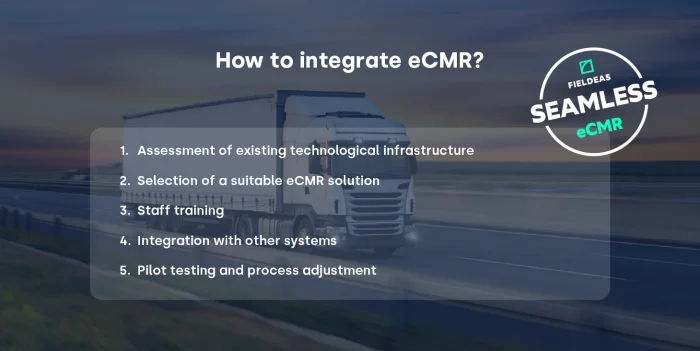How to integrate eCMR into your company: A step-by-step guide to digitizing transportation


We have already talked several times in this blog about the importance of starting the digital transformation of transportation with document digitalization or eCMR. On this occasion, we are going to make a guide on how to integrate eCMR in a company.
For shippers and carriers looking to integrate eCMR into their operations, the process may seem complex, but with the right strategy, the benefits are substantial.
In this article, we will explore how to integrate eCMR into your company effectively, how to adapt to legal requirements and what the chosen technology solution should look like to facilitate the transition to this digitization.
The eCMR (Electronic Consignment Note) is the electronic version of the paper consignment note, which certifies the contract between shipper, carrier and consignee in road transport operations.
This document serves as proof of delivery, agreement between the sender and the carrier, and control of the goods during the journey.
Although there are different transport documents (control document, consignment note, CMR or delivery note), the digitization of transport documents makes it possible to bring together all the documents required for shipments in a single point. Thus, throughout this post we use eCMR as an umbrella concept for document digitization.
Integrating eCMR in a transport company means taking a step towards the automation of logistics processes, allowing for faster documentation management, reduction of human errors and greater traceability of goods.
In addition, eCMR already has full legal and regulatory guarantees, both in Spain and in Europe.
Read the post eCMR in Spain: complete guide to the digital consignment note, regulation and time horizons to understand the regulatory framework surrounding the digitalization of transport documentation.
Integrating eCMR into your company is not just about replacing paper with a digital solution. It is a comprehensive change that requires proper strategic planning.
Here are the essential steps to successfully integrate eCMR:
Before integrating eCMR, it is essential to make an analysis of the company’ s current technological infrastructures.
This includes transportation management software (TMS), dock management system or YMS, warehouse management systems (WMS), ERP, CRM and other systems with which the eCMR must integrate.
Once done, it is important to plan the necessary updates to facilitate the integration.
The next step is to choose an eCMR platform that fits the needs of your company. It is important to select a solution that is not only easy to use, but also offers key features such as:
In this regard, FIELDEAS Track and Trace’s SeamLess eCMR offers a robust and flexible solution that enables full eCMR integration, with functionalities such as advanced digital signature, automatic validations and real-time tracking of shipments.
Integrating a new technology implies a cultural change in the company.
Therefore, it is crucial that all employees are properly trained to use the new eCMR platform efficiently.
This will ensure a smooth transition and avoid operational errors during the adoption process.

The eCMR is not an isolated solution, but must be connected with other systems in the company, such as the TMS, WMS, ERP, CRM, YMS…
Integration with these platforms facilitates process automation, eliminating the need to re-enter data in different systems and reducing the risk of errors.
Once the eCMR platform is installed and staff trained, it is important to conduct a pilot test with a few shipments to identify possible areas for improvement.
During this trial period, adjust processes as needed, ensuring that all workflows are efficient and that data is being managed correctly.
The transition to a digital waybill management system offers numerous benefits for transport and logistics companies:
By eliminating the need to manage paper documents, companies reduce the costs associated with printing, storage, distribution and physical archiving.
In addition, administrative times are optimized by automating tasks that were previously manual.
Digitization allows faster and more accurate management of documentation. Data is entered only once, avoiding repetition on several platforms and reducing the possibility of errors.
In addition, access to real-time data improves decision making and facilitates problem solving.
International transport legislation is becoming increasingly digitization-oriented.
Thus, the adoption of eCMR makes it possible to comply with legal regulations that promote the migration to electronic documents, especially in the context of international transport.
With eCMR, all parties involved in the transport process (shipper, carrier and consignee) can access information in real time, improving control over the status of the goods and providing full traceability of the cargo.
The eCMR is one of the most outstanding modules of FIELDEAS Track and Trace, an advanced, flexible and secure Supply Chain Visibility platform.
This software allows real-time supervision of multimodal transport operations and provides traceability of shipments from origin to delivery at destination by monitoring key information.
Taking into account the advantages and challenges and the main features that an eCMR solution must have, the FIELDEAS Track and Trace SeamLess eCMR offers full legal and juridical guarantee.
In addition, it provides a complete view of the loading and unloading process, streamlines logistics processes, reduces costs, facilitates document management, eliminates errors in the transmission of information, provides greater transparency, promotes traceability and boosts sustainability.
In addition, FIELDEAS Track and Trace SeamLess eCMR offers complete flexibility by ensuring interoperability with other enterprise systems and other visibility platforms.


08 May 2025
Types of digital signature in transportation documentation and when to use them

14 May 2025
FIELDEAS SeamLess eCMR: how does it work and how can it help you?

11 Jun 2025
Document digitisation in the transport of dangerous goods: ADR 2025

17 Jul 2025
New boost to the digitalization of freight transport: MTMS launches a Royal Decree